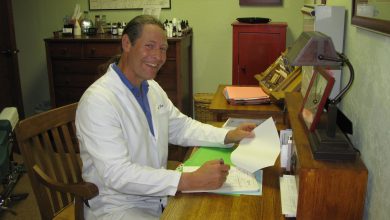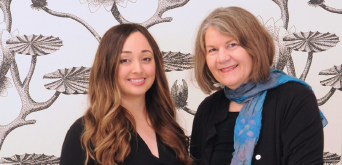Jane Barton, LMT
 A Certified Manual Lymph Drainage Therapist (Vodder technique), Rubenfeld Synergy Practitioner, and Licensed Massage Therapist, Jane Barton has practiced in Ashland for the past 11 years. She has had a diverse practice in these three complementary modalities, and Manual Lymph Drainage is her primary area of work now. Passionate about what she does, Jane is continually amazed by the depth and richness she finds in her work. I spoke with Jane recently about her work as a practitioner of Manual Lymph Drainage (MLD).
A Certified Manual Lymph Drainage Therapist (Vodder technique), Rubenfeld Synergy Practitioner, and Licensed Massage Therapist, Jane Barton has practiced in Ashland for the past 11 years. She has had a diverse practice in these three complementary modalities, and Manual Lymph Drainage is her primary area of work now. Passionate about what she does, Jane is continually amazed by the depth and richness she finds in her work. I spoke with Jane recently about her work as a practitioner of Manual Lymph Drainage (MLD).
Jane, thank you for doing this interview with us today. Over the past 11 years your practice has taken you deep into the work of the lymphatic system. What was your original inspiration in this body of work?
I began studying body work 11 years ago and MLD (Manual Lymph Drainage) 4 years ago. I took the 135 hour training because I needed Continuing Education Units for my massage license, and to my surprise was fascinated with the work. One of the main MLD therapists in this area, was retiring and turned her practice over to me at that time, so I immediately began working on clients with ongoing lymphedema. She became my mentor and provided me with support and knowledge. Since there isn’t a lot of research on the lymphatic system or education for health practitioners, it was helpful to have someone with experience to pass on what she has learned.
Jane can you give us a basic introduction to lymphedema?
Most people know of lymphedema as a result of having had a mastectomy. This is the most common reason in the United States. When mastectomies were done years ago, the lymph nodes under the arm pit were removed. The lymph nodes process lymph and when they are removed the lymph is not able to be processed adequately and it gets backed up. This results in swelling, in this case the arm is where it shows up the most. The surgery done now uses sentinel node for cancer identification in the lymph nodes. This is the node closest to the cancer allowing for less invasion into the lymphatic system.
Most people have very little knowledge about their lymph system until it is damaged. As a person who was diagnosed with breast cancer and had a bi-lateral mastectomy, I found out months later that my system was not working right. My surgeon did not address the possibility of getting lymphedema after he removed my lymph nodes. During the summer months, my lymph system gets backed up and cannot circulate properly. A lymph massage helps me get my circulation back into action so that I can cool down properly. If your circulation is not working properly, the arm can swell up. My monthly massage keeps my body’s lymph in good working order.
-NS
What are some signs and symptoms of lymphedema?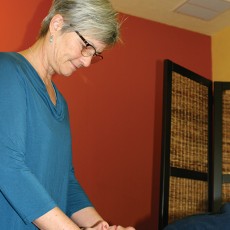
There is primary and secondary lymphedema. Primary you are born with and it means that there is a weakness in the lymphatic system somewhere. Secondary is a result of a compromised lymphatic system from injury, surgery, radiation, infection, etc. With both types of lymphedema it can begin immediately, months or years after injury to lymphatic system or it may never show up at all. The lymphatic system processes 3-4 liters a day of fluid, (lymph load). Imagine a tank called the transport capacity in a diagram (for demonstration sake). It represents your lymphatic (vessels and nodes) ability to processes the lymph load which varies in amount. When we get sick, stressed, fight disease, have injuries, the amount of lymph load rises in the tank. In a person with a normal lymphatic system the amount of lymph load doesn’t fill the tank, and there is no spill over. In a compromised lymphatic system the tank is smaller. It is possible for the lymph load to spill over, figuratively speaking. Still, even with a compromised lymphatic system, our systems can deal with a lot before we push the system into overload. We rarely fill the tank. My clients with lymphedema usually notice a tenderness, or sense of fullness where it is backing up.
Are there certain situations that can cause lymphedema?
In order for lymphedema to occur, primary or secondary compromises to the lymphatic system must be in place, i.e. post-radiation, injury, infection, or surgery. I have a client who was having tenderness in her foot and a bit of swelling. She couldn’t get anyone to tell her what was wrong. When she traveled by air on a trip, the foot as she said “blew up” causing a bubble like swelling, including the toes. She has lymphedema in the foot, called latent lymphedema because it occurred after time had passed from the original compromise. People with lymphedema usually wear compression garments of some kind to prevent an exacerbation of lymphedema, especially on planes.
What actually is lymph?
The arterial part of our cardiovascular system delivers oxygen, nutrients, proteins and water to cells and tissues of the body. The arterial capillaries deliver this in a clear fluid called plasma that floods the interstitial space (space between cells). The venous capillaries then pick up 80% of the water, cell debris, and metabolism by-products to return to the blood. The lymphatic capillaries pick up the remaining 20% filtrate plus the proteins. The arterial capillaries have big enough openings to deliver proteins, but the venous capillary openings are not big enough to pick them up. This fluid becomes lymph when it enters the lymphatic vessels. Lymph is a protein rich fluid.
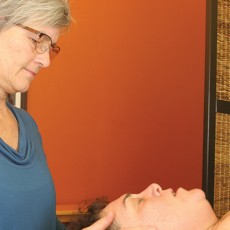 How do you work on someone with lymphedema?
How do you work on someone with lymphedema?
My primary work is with the superficial part of the lymphatic system. This is a fine web of vessels that covers the entire body. Unlike the deeper vessels, the superficial (about a hair’s width beneath the skin) do not have valves or nodes. So when you press on it, the lymph can spread in all directions. When working with someone with lymphedema, I want to move lymph from the area of congestion to an area with lymph nodes not compromised and with less congestion; rerouting lymph. This is slow, light work because of the thick fluid and lack of valves. It is also very directional. We have 600-700 lymph nodes throughout the body but there are more in groups in the axilla, groin, abdomen and the neck area, called regional nodes. The regional lymph nodes receive lymph from a particular part of the body. When moving lymph I am directing it to a particular group of regional nodes. I feel it is important to note that lymphatic swelling should ALWAYS be addressed before it further damages the lymphatic system.
Once you are working with a client how often do you see them?
That varies. Once you have lymphedema, you always have lymphedema. How much of a problem it is depends on the individual. Part of the beginning treatment for lymphedema is an appointment with a physical therapist that does MLD. They will measure you for compression garments, teach daily home care, and begin your education about lymphedema. After that it is an individual choice about care.
Some clients see me twice a week for half an hour. Some come every two, six, or eight weeks. Some come when they feel that full, tender sensation. Each body is different in how much and how often it swells. Also, everyone has their own comfort and tolerance level for the swelling. Yes, you can do home care, and need to daily, but having someone do it for you can work in a different more deliberate way once in a while. It can also be a very nurturing, relaxing and renewing time.
What about treating cancer patients?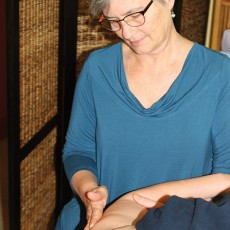
I treat cancer patients after they have completed radiation and/or chemotherapy.
I am 73 year old male who first encountered lymphedema following radiation with a curative intent to my right humerus in 2001 – the lymph glands in the right axilla were apparently adversely affected by the radiation. Lymphedema in my right arm and hand became evident a few months following the conclusion the radiation. This edema rapidly progressed, necessitating the intervention of a physical therapist to provide hands-on MLD and instruction in compression wrapping techniques. This foregoing treatment one would classify as acute. This lasted for several weeks. Following this acute phase, I then began chronic prophylactic MLD by way of the services of licensed massage therapist who had further training (about two weeks) in MLD. I continue this therapy to date. The benefit I have observed with this prophylaxis is reduced edema in my left hand. I can perceive 1mm edema in my fingers. This edema is relieved with MLD. I have directly measured this change. I have noted that when the MLD strokes are applied directly over the area of the right humerus, the site of the radiated cytoma and fractures, there is distinct sensation of pleasure – these light strokes feel very good. It is my opinion that, the light, repetitive strokes that are the hallmark of MLD, are more relaxing and calming than any other form massage.
James Voeller
December 2013
Do you use MLD for reasons other than lymphedema?
Yes, actually I do. One of the jobs of lymph nodes is to break down foreign bodies or toxins that enter the body. When the nodes detect something foreign they begin work to break it down before it goes through the whole body. I’m sure we have all experienced this when we have tender nodes in the neck preceding a cold or virus. This is a time when I like to let the body do its work. I don’t work on sore lymph nodes, I let them do their job. When someone is at the end of a cold or virus, I find it helpful at this time to increase lymph flow with a short session.
I have had good outcomes with sinus congestion, sore muscles and joints, and pain and swelling from injury. It is also helpful for people who have had whiplash. It relaxes groups of muscles all at once and it calms the nervous system, helping with the trauma. The last training I had a physical therapist told me that their clinic doesn’t even begin to work on clients until they have had 2-3 MLD sessions first. Whenever there are injured tissues, you have an increase in lymph to that area for healing. I find MLD decreases pain, and increases healing by keeping fresh lymph moving through the area. When a person is getting ready for surgery, I recommend coming in before to begin to reroute the lymph for that area. I also see people who are detoxing. MLD helps by increasing the transport of debris throughout the system. I also get MLD every two weeks for half an hour. It increases lymph flow for about 2-3 days.
Jane, I am so grateful that you do manual lymph drainage!!! My back thanks you!! For many years I have had chronic, intermittent low back pain. After a half hour session with you focusing on my abdomen, I am usually pain free for 5-10 days. Amazing!! The work is so gentle and so relaxing it still surprises me that it is so very effective!! Thank you for the wonderful work!!
Sue
What do clients feel like after a session?
Very relaxed; it calms the nervous system and relaxes muscles, what a great combo!
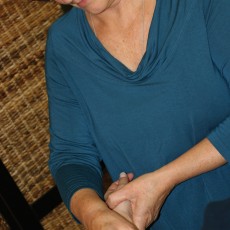 You mention that the more you learn, the bigger the subject becomes. Tell me more.
You mention that the more you learn, the bigger the subject becomes. Tell me more.
Recently I took another class on MLD and learned some new research. They are finding that lymph vessels in the arms of some people have already rerouted in the way that we try to do it manually. I guess this would be a beneficial defect in their lymphatic system if they have lymphedema in the arm. Also, research is showing that lymph vessels regenerate. There is more research being done all the time so there is always more to learn. When I first took the training they were telling us that clients shouldn’t exercise or get massages. Now they say exercise to a point is good and my anecdotal learning is that massage can work with some clients. The problem would be creating more lymph or pushing it into regional nodes that are compromised. I’m finding it works well as a combination treatment, 1/2 massage, 1/2 MLD for some clients. This type of practice allows me to continue learning.
Learn More:
Jane Barton
541-890-1830
janebartonlmt.com


